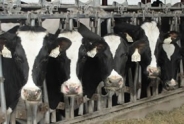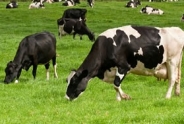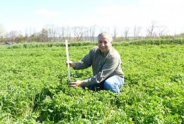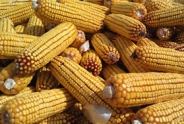Would a National Checkoff fit Organic?
A. Fay Benson, Small Dairy Extension Educator
South Central New York Dairy & Field Crops
What is a National Checkoff Program?by Elizabeth Burrichter, Organic Dairy Educator, Cortland County CCE
Do the sayings, 'Got Milk?', 'Beef: It's What's for Dinner,' or 'Pork. The Other White Meat' sound familiar? These promotions are all part of National Research and Promotion Programs, also known as commodity checkoff programs. These programs, overseen by the USDA, collect funds, called checkoff dollars or assessments, from producers, handlers or processors of a particular agricultural commodity. The goal of these programs is to maintain and expand existing markets, as well as to develop new markets. Some checkoff programs also fund agricultural production research.
The Organic Trade Association (OTA) has lobbied for such a program to promote the organic industry and distinguish it in the marketplace. The OTA believes that a major challenge for the organic sector is consumer confusion about what organic stands for, and this program would seek to help the consumer understand all that organic delivers through collective resources and coordination.
Unfortunately, the organic community is split on their support of this idea for an organic checkoff program.
Hurdles to such a program:
- Currently, 100 percent organic operations are exempt from any checkoff assessments under the 2002 Amendment.
- Before an organic checkoff program could take place, organic products would have to become a single commodity. The Commodity Promotion, Research, and Information Act of 1996 does not allow for more than one commodity to be part of a checkoff program, but OTA's proposal is to change that Act so that organics could become a single commodity.
- Several checkoff programs include a research component as an output, but because of the breadth of products included in this organic program, the research component would be the weakest link in the proposal. If all organic products are a single commodity, then research dollars would need to be spread evenly across every different production system. The diversity within organic production, i.e. field crops, orchards, vineyards, greenhouse production, etc., would prohibit the possibility of conducting thorough production research across all organic fields, which would be extremely expensive. Since production research would not be the main output of this program, funds would be focused on promoting organic products.
- Creating a conflict of interest is prohibited within the program. This means that all promotion must be generic, and that promotion cannot disparage another agricultural commodity. Funds cannot influence governmental action or policy or "pass through" the program in order to fund another organization. Any promotion that results from an organic checkoff program cannot promote organic food as better than conventional, but can explain exactly what organic certification entails as a production claim.
The current Farm Bill proposal addresses some of the hurdles to an organic checkoff program, with identical language in both the House and Senate versions. This text would allow for a â??technical fixâ?? in the regulatory language so that all split operations (farms that produce both organic and conventional products) would be exempt from conventional checkoff assessments, and not just operations that are 100% organic. Those opposed to the checkoff at the NY Organic Dairy Task Force meeting were in fact supportive of this measure.
While an organic checkoff program directed at consumer education sounds like a good idea, in actuality it would be very difficult and costly to attempt. Those involved in the organic dairy market know it was not created by a clever media campaign from Madison Avenue. It was created by dairy consumers demanding an alternative to milk from cows treated with Bst which began in 1994. How best to keep the trust of consumers is something every organic farmer should invest interest. To weigh in on the subject farmers can go to one of the websites listed below or they can go directly to their elected official in Washington.
http://www.ota.com/ORPP.htmlhttp://www.nodpa.com/checkoff_opposition.shtml
The New York Organic Dairy Task Force has been funded by the New York Farm Viability Institute since 2005. The Task Force is comprised of both organic dairy and crop farmers, certifiers, processors, and related support services. They meet twice a year and review opportunities and barriers to the organic dairy industry in New York. For more information go to: http://cuaes.cornell.edu/organic/projects/dairy/dairy-initiative/
Upcoming Events
Winter Bale Grazing Pasture Walk
January 10, 2026
Truxton, NY
Join us for the second Bale Grazing Winter Pasture Walk!
Have you heard about or seen bale grazing and wondered if it would work for you?
Do you want to learn the nuances and logistical context for implementing this regenerative practice?
Are you interested in seeing the impacts of bale grazing on land and animals from a practicing farmer?
If you answered Yes to any question, The Northeast Region National Grazing Lands Coalition, the Cornell Cooperative Extension Hillside Farms are teaming up to showcase our Second Bale Grazing Winter Pasture Walk!
Boots in the Barn: Webinar Series
January 13, 2026
Boots in the Barn: Cornell Dairy Research Updates
Webinar Series every Tuesday starting January 13th @ 12:00pm to February 24th.
2026 Winter Crop Meeting
January 22, 2026
Auburn, NY
Connect with the agricultural community and many key note speakers on the folllowing topics:
- Emerging Innovation in Plant Breeding and Technologies - A Peek at the Future by Ben Rogers, Pioneer Field Agronomist
- Managing Herbicide-Resistant Weeds in NY Corn & Soybean by Dr. Vipam Kumar, NYS Extension Weed Scientist, Cornell University
- Livestock Risk Protection (LRP) Insurance Program by KC Slade, Risk Management Specialist, Farm Credit East—Crop Growers
- Birds & the Bees Legislation and the Fate of Neonics by Janice Degni, Extension Field Crop Specialist
- Emerging Disease Pests and Soil Borne Diseases of Soybean by Dr. Camilo Parada Rojas, NYS Extension Plant Pathologist, Cornell University
- Solar Farms—Benefit or Detriment? by Mr. Michael McMahon, Chair, Homer Town Planning Board
4 DEC credits in categories 1A and 21-25. 1.5 PM, .5 CM and 1 PD CCA credits available.
Please send your DEC license number in the Notes to Us when you register on-line.
Announcements
USDA Contract Freezes and Terminations: Legal Action Steps for Farmers
For Farmers with Signed EQIP and CSP ContractsThis resource is written for farmers and ranchers nationwide who have a signed contract with USDA NRCS under the EQIP or CSP program for environmental improvements but have concerns that their contract is frozen, under review, or terminated, and who are uncertain of their rights to receive reimbursement as well as their ongoing obligations under the signed contract.
Version: 1.0
Issue date: Feb 28, 2025
A downloadable factsheet is available at our BUSINESS tab on the top of our webpage.
Additional Information: www.farmcommons.org
USDA Contract Freezes: Filing an NAD Appeal or Demand Letter
This resource is written for farmers and ranchers nationwide who have a signed contract with USDA NRCS under the EQIP or CSP program for environmental improvements and want more information on the mechanics of filing a National Appeals Division (NAD) appeal. This resource includes sample letters.
USDA NAD Appeal https://www.usda.gov/about-usda/general-information/staff-offices/office-hearings-and-appeals/national-appeals-division/nad-appeals
Farm Participants Needed for Bale Grazing Grant!
Information on the Project:- Approximately 10 acres total needed to bale graze two different bale densities
- "Core" farms will graze two winters, "Demo" farms will graze one winter.
- Payments for both "Core" farms and "Demo" farms
- Baseline soil sampling by bale grazing team
- Forage measurements in early season by bale grazing team
- Late season clipping if residual not trampled down by farm
Cornell Cow Convos - New Podcast
On-going podcast, New episodes released on the last Thursday of the month.Guest speakers, CCE Dairy Specialists.
Housed on Soundcloud Channel is CCE Dairy Educators
- Preventative healthcare for cows
- The trend of beef on dairy
- What to look forward to in the new year for dairy
- Socially grouping or pair-housing calves
2018 Drug Residue Prevention Manual
For more than 30 years, the U.S. dairy industry has focused educational efforts on the judicious use of antibiotics through the annual publication of a Best Practices Manual. The 2018 edition of the National Dairy FARM Program: Farmers Assuring Responsible Management? Milk and Dairy Beef Drug Residue Prevention Manual is the primary educational tool for dairy farm managers throughout the country on the judicious and responsible use of antibiotics, including avoidance of drug residues in milk and meat.The manual is a quick resource to review those antibiotics approved for dairy animals and can also be used as an educational tool and resource for farm managers as they develop on-farm best management practices necessary to avoid milk and meat residues. Visit the Manual and Form Library to download copies of this important tool!
Follow us on Facebook
The team updates our facebook page frequently - follow us to be updated on our events, see some fun videos and get local area updates!facebook.com/SCNYDairyandFieldCropsTeam
NYSERDA Agriculture Energy Audit Program
NYSERDA offers energy audits to help eligible farms and on-farm producers identify ways to save energy and money on utility bills. Reports include recommendations for energy efficiency measures.For more information and the NYSERDA Agriculture Energy Audit Program Application click here





